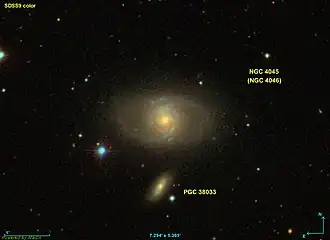NGC 4045
| NGC 4045 | |
|---|---|
 NGC 4045 imaged by SDSS | |
| Observation data (J2000 epoch) | |
| Constellation | Virgo |
| Right ascension | 12h 02m 42.2488s[1] |
| Declination | +01° 58′ 36.271″[1] |
| Redshift | 0.006591±0.00000334[1] |
| Heliocentric radial velocity | 1,976±1 km/s[1] |
| Distance | 100.24 ± 2.77 Mly (30.733 ± 0.849 Mpc)[1] |
| Apparent magnitude (V) | 12.9g[1] |
| Characteristics | |
| Type | SAB(r)a[1] |
| Size | ~87,500 ly (26.82 kpc) (estimated)[1] |
| Apparent size (V) | 2.38′ × 1.14′[1] |
| Other designations | |
| HOLM 320A, IRAS 12001+0215, NGC 4046, UGC 7021, MCG +00-31-022, PGC 38031, CGCG 013-046[1] | |
NGC 4045 is a barred spiral galaxy in the constellation of Virgo. Its velocity with respect to the cosmic microwave background is 2,334±25 km/s, which corresponds to a Hubble distance of 112.3 ± 8.0 Mly (34.42 ± 2.44 Mpc).[1] However, 15 non-redshift measurements give a closer mean distance of 100.24 ± 2.77 Mly (30.733 ± 0.849 Mpc).[2] It was discovered by German-British astronomer William Herschel on 20 December 1784.[3][4] It was also observed by German astronomer Heinrich Louis d'Arrest on 10 April 1863, causing it to be listed a second time in the New General Catalogue, as NGC 4046.
NGC 4045 is a LINER galaxy, i.e. a galaxy whose nucleus has an emission spectrum characterized by broad lines of weakly ionized atoms.[1] Also, the galaxy is listed as having an active galactic nucleus, and as being a radio galaxy.[5]
NGC 4045 and neighboring galaxy PGC 38033 (also known as NGC 4045A) are listed together as Holm 320 in Erik Holmberg's A Study of Double and Multiple Galaxies Together with Inquiries into some General Metagalactic Problems, published in 1937.[6] However, since PGC 38033 is over twice as distant (~81.6 Mpc)[7] as NGC 4045, the grouping is purely an optical alignment.
Supernova and luminous blue variable
One supernova has been observed in NGC 4045:
- SN 1985B (Type II, mag. 13) was discovered by Shingo Horiguchi on 17 January 1985.[8][9] A 1987 study classified this supernova as Type Ia.[10]
One luminous blue variable has been observed in NGC 4045:
- AT 2019wbg (Type LBV, mag. 18.775) was discovered by ATLAS on 3 December 2019.[11] It was initially classified as a supernova impostor, then as a Type IIn supernova. In June 2020 it was finally classified as a luminous blue variable, due to its continued up-and-down variability and low luminosity.[11] Since then, it has exhibited repeated outbursts which have confirmed this classification.[11]
See also
References
- ^ a b c d e f g h i j k l "Results for object NGC 4045". NASA/IPAC Extragalactic Database. NASA and Caltech. Retrieved 1 August 2025.
- ^ "Distance Results for NGC 4045". NASA/IPAC EXTRAGALACTIC DATABASE. NASA. Retrieved 1 August 2025.
- ^ Herschel, W. (1786). "Catalogue of One Thousand New Nebulae and Clusters of Stars" (PDF). Philosophical Transactions of the Royal Society of London. 76: 457–499. Bibcode:1786RSPT...76..457H. doi:10.1098/rstl.1786.0027.
- ^ Seligman, Courtney. "New General Catalogue Objects: NGC 4045". Celestial Atlas. Retrieved 1 August 2025.
- ^ "NGC 4045". SIMBAD. Centre de données astronomiques de Strasbourg. Retrieved 1 August 2025.
- ^ Holmberg, Erik (1937). "A Study of Double and Multiple Galaxies Together with Inquiries into some General Metagalactic Problems". Annals of the Observatory of Lund. 6: 1. Bibcode:1937AnLun...6....1H.
- ^ "Results for object NGC 4045A". NASA/IPAC Extragalactic Database. NASA and Caltech. Retrieved 1 August 2025.
- ^ Kosai, H.; Kozai, Y.; Horiguchi, S. (1985). "Supernova 1985B in NGC 4045". International Astronomical Union Circular (4035): 1. Bibcode:1985IAUC.4035....1K.
- ^ "SN 1985B". Transient Name Server. IAU. Retrieved 1 August 2025.
- ^ Wegner, Gary; McMahan, Robert K. (1987). "Spectroscopy of the Supernova 1982V, 1984A, and 1985B". The Astronomical Journal. 93: 287. Bibcode:1987AJ.....93..287W. doi:10.1086/114312.
- ^ a b c "SN 2019wbg". Transient Name Server. IAU. Retrieved 1 August 2025.
External links
 Media related to NGC 4045 at Wikimedia Commons
Media related to NGC 4045 at Wikimedia Commons- NGC 4045 on WikiSky: DSS2, SDSS, GALEX, IRAS, Hydrogen α, X-Ray, Astrophoto, Sky Map, Articles and images